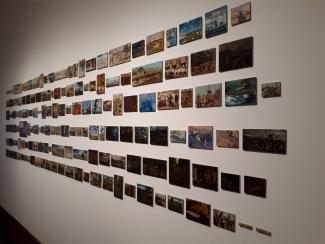
In the series ‘The role of culture in Indonesia’ Remco Vermeulen, advisor Indonesia, monitors the dynamics within Indonesia’s cultural sector. This is part 1.
On Tuesday 16 February 2018 I visited the EUROPALIA exhibition ‘Power and other things’ at Bozar in Brussels, just a few days before its closing. On that same day, a devastating fire raged through Jakarta’s Maritime Museum. This made for an intense day, which got me thinking of the role of art in Indonesia in relation to the shared history with the Netherlands.
Art to connect
Art provides a means to express emotion, or to discuss a sensitive topic. It can bridge the gap between history and present or even future, and create understanding of a point of view that may be very different from our own. For ‘Power and other things’, its curators Riksa Afiaty (Indonesia) and Charles Esche (Netherlands) invited Indonesian, Australian and European artists to reflect on the history of Indonesia and its multifaceted identity. Or as Afiaty explained: “(It) is not only about the big narrative, but also about the fragmented histories of Indonesia that we may have forgotten”. Just a few of those fragments presented to the audience were the Dutch concentration camp Boven-Digoel for political opponents via photography and film, a textile installation on the continuing prosecution of Chinese living and working for generations in Indonesia, the showcasing of 153 miniature copies of Japanese WWII paintings or the two very different depictions of the capture of prince Diponegoro (one by the Dutch Nicolaas Pieneman, one by the Indonesian Raden Saleh). The exhibition sought to display the connections of art with “history far beyond Indonesia’s borders”, in order to build a bond between people.

The courtyard of the Maritime Museum, Jakarta after the fire of 16 January 2018 (JG Photo, Yudha Baskoro)
A museum as link between past and present
This connection between art and history is also tangible in the Maritime Museum in Jakarta, which presents the archipelago’s maritime history and is located in former 17th century Dutch East India Company warehouses. The complex recently reopened after a major restoration, which befitted the revitalization of the historical inner city of Jakarta, Kota Tua (formerly known as Batavia), and the new governor Anies Baswedan’s strive to make the capital more attractive for tourists. All the more regretful that the fire damaged part of the museum and collection. It did however attract a lot of attention: major international media were covering the fire and its aftermath, the local government immediately formed an all-expert crisis team and several countries including the Netherlands offered their assistance. Although a month later this attention has somewhat died down, the Maritime Museum’s importance for the city as a link between past and present, through its building and its collection, is apparent and acknowledged.

